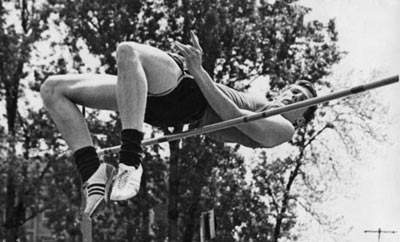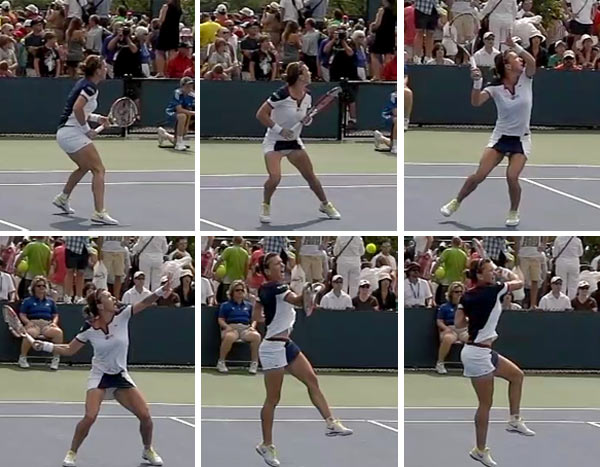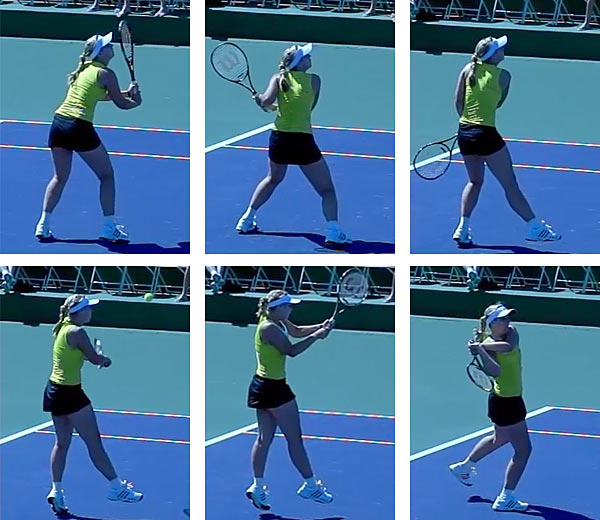|
TennisOne Lessons Swinging Topspin Volley Dave Smith, Senior Editor Perhaps one of the shots in tennis that most define the evolution of the modern game is the swinging topspin volley. While certainly the speed of the game—from serve to the groundstrokes—has changed dramatically over the past 30 years, the fact is, the topspin volley was almost non-existent a generation ago. The speed of shots could be simply considered an extrapolation of the existing swing technique among serves and groundstrokes…just done faster! The swinging topspin volley, on the other hand, is far removed from the conventional slice volley that existed almost exclusively for more than one hundred years.
Dynamics of Change Few other sports have experienced the kind of technical adaptations in their games. One might recognize the “Fosbury Flop” as a significant technical change in high-jumping. Yet, I can’t think of too many other examples of significant technical change in a sporting activity that might be considered dramatic. (Strategic changes have occurred in all sports, agreed!) Yet this game of ours is only a distant cousin to the game played only 20 or 30 years ago. I believe the dynamics of change is extrapolated via three means: 1) More effective mechanics; 2) Evolutionary change due to other, more subtle changes; 3) Coolness factor. (And let's not forget the size and dynamics of the modern racquet which had a pronounced effect on the grips and swing paths used in the modern game.) As for the swinging topspin volley, I think we can see that all three of these factors have contributed to more players using the shot.
More Effective Mechanics The conventional volley, using a continental grip, imparting a underspin for control, and using a short compact stroke, has similar limitations that a conventional slice forehand or backhand groundstroke has: It can’t be hit too hard without the ball sailing long. While adding slice decreases the ball’s velocity, and thus creates an essence of control, underspin as a physics parameter, when hit too hard, will cause a ball to rise, not drop. Hitting a ball with topspin has the opposite effect — the more spin, the more it will arc downward into the court. In the old days, teaching consistency was the rule. Thus, excessive swing on any shot was questioned in terms of adding complexity to aim and timing. However, today, we recognize that if we swing within a context of a “repeatable and reliable” swing path, the complexity of timing and aim is simplified. Today, players are trained to replicate a swing with almost robotic-like precision. This has opened the door to the swinging topspin volley, from this perspective. The ability to take a high, floating ball and basically rip the ball with spin and speed, offers up a far more offensive and effective result than blocking or slicing the same ball with the conventional volley stroke. Evolution Due to Change Because more players, especially juniors, are taught within a groundstroke foundation (sadly, in many cases, the volley is an afterthought among some teaching programs!), the aspect of coming to the net and using a continental grip can be extremely foreign. Thus, many players found that swinging with almost the exact same stroke, grip, and footwork as their aggressive topspin groundstrokes from the baseline felt more natural and seemed, at least for them, to work just as well—if not better—than trying to learn to volley with the conventional grip and slice stroke.
Another factor in this change is the aforementioned racquet advancements. A heavy, wood racquet of a generation ago, would have made the practice of a swinging volley more daunting. Because of the need for speed as well as stability, using a heavy racquet, for many, was very cumbersome and slow. And as with any innovation, once a high level player (in this case I believe Andre Agassi was among the first to use this shot on a regular basis) has success others quickly incorporate it into there own games. On the Women's tour, many players hit this shot instead of an overhead. On the other hand, lower balls are far more difficult to execute with a swinging stroke (facilitating the need to still learn to volley with conventionality!), however, the success of early practitioners of the swinging volley' like Agassi, could not be ignored when faced with a mid to high ball taken out of the air from mid court or even closer. Coolness Factor Like all aspects of a power game, most kids and adults alike see an aggressive, full-power swinging topspin volley winner as being more impressive—and thus cool—compared to the conservative conventional volley execution. It should come as no surprise that kids watching pros on television want to emulate what they perceive as cool. And thus, a shot is born! Keys to Swinging Volley Success The key to success on any aggressive shot is the ability to create what I call a “repeatable, reliable swing path on command.” So, for us to be able to hit this shot with any semblance of effectiveness, consistency, and success, we first better have down groundstrokes that fit this same criteria. The swinging topspin volley is nearly the same stroke that a player would use to hit a topspin groundstroke. However, there is one main difference: location of contact. The topspin volley is more consistent and effective when hit as early and as high as some conventional overheads. Ideally, the swinging topspin volley needs to be hit above the waist to just over head-high. As a teaching pro, I try to teach players to hit full overheads when ever possible…including a lower lob where contact might be made just above the head. (However, I do not recommend abandoning the full overhead in favor of the swinging topspin volley which I see much too often, especially on the women's tour!) Remember, we can always use our legs to lower our body and raise this contact point relative to our head to hit a full overhead on lower lobs. However, if we feel we can create as much, if not more, effectiveness using the swinging topspin volley, why not use it?
Moving Forward In many cases, the volley attempt in today’s game is hit further back in the court. The reason for this is that many players today don’t play a conventional net-attacking game. We see the conventional “serve and volley” or “chip and charge” style of attacking the net used as much. Most approach shots are hit from a static position, that is, a big ground stroke hit off of an opponent's weak defensive shot, one that is high and floating. Thus, players now come in later (once we recognize the floating shot), look to take this ball out of the air rather than letting it drop. This takes time away from the opponent. Such a shot usually fits the criteria for the ideal swinging topspin volley. Running forward towards this shot is really no different than running to hit virtually any normal topspin groundstroke.
Common Problems One of the common issues we see when players do attempt the swinging topspin volley is the perception of hitting the ball “down.” Similar to what we see players do with high conventional volleys, players often perceive the need to hit down on a high volley. The problem is, because of the angle of reflection, any opponent’s ball that is coming down from a higher position will reflect downward off our racquet when struck, even if we don’t hit specifically down on the ball! Thus, players are often surprised when they bury a high volley into the bottom of the net. With the swinging topspin volley, it is even more important to remember to still hit “UP” on the drive and not to cover the ball with the racquet face. Unlike groundstrokes where we often hit up to clear the net, the high volley is already above the net. However, we still want to drive UP and THROUGH the ball and not “roll” the racquet over the ball.
Practice Practice, practice and then practice more. Do not expect to convert this shot consistently during match play with out putting in the work on the practice court. The easiest way to work on the shot is to have a partner hit balls soft and high with you starting just behind the service line. Work on moving your feet forward and preparing early with a good upper body and shoulder turn. (Often, we see players move forward and the natural body position is facing the net as we move in.) Shorten your backswing slightly and then attack the ball with your typical topspin groundstroke swing. Aim higher than you normally might as the higher contact point tends to make the player close the racquet face more than they would on a groundstroke. I prefer to have students hit these first practice balls long. It is easier to simply add more upward topspin to make the ball drop down than to have to try and open the racquet face or aim higher to keep the ball from going into the net.
Forehand and Backhand Notice I’ve not differentiated between hitting a forehand and backhand swinging volley. This is because they are identical to the groundstroke as previously mentioned. The common problems are the same on both sides. Typically, players who swing with two hands have an easier time controlling the swinging topspin volley because the hands work together to control the racquet and maintain stability. However, there is a simple phrase I use to help players on almost all strokes that works really well for the swinging topspin volley: “Keep the Plane the Same.” This concept, of not allowing the racquet face to roll or change during the stroke is a key component of consistency on all shots. The “Plane” of the racquet is simply the racquet face. Keeping the integrity of the racquet face the same on all shots will allow the player to hone in on aiming and gain more consistency and confidence on the same shot hit over and over. Keep that simple phrase in your head to improve your strokes on all groundstrokes, volleys and slice shots. You will discover how fast you can improve your game! One-handed vs. two-handed swinging volleys: One question I often get is should I use my two-handed stroke on the swinging volley? With either a two-handed backhand or the less used two-handed forehand, the answer is absolutely. Using two hands on your groundstroke will be no different for the swinging volley then it would be for a groundstroke. However, care must be understood in that the non-dominant hand often tries to bring the racquet over the ball on higher balls. Two-handed players must remember to “keep the plane the same” and NOT let the racquet ‘roll’ over the ball. One-handed swinging backhand volleys are more difficult to execute than two-handers. First, the player should have an exceptional one-handed topspin groundstroke to even begin to consider the swinging volley on the backhand side. Because one of the weakest shots for many players is a high ball on the backhand side, adding a full, swinging aspect to this shot is fraught with danger! Like we have mentioned, for an effective and consistent shot, we need to retain the integrity of the racquet face within the contact phase. With one hand, the player must maintain stability in the wrist and forearm. It is very easy for one-handed players to “flick” the racquet at this high backhand volley. Players must remember to turn more sideways on the backhand side to facilitate the arm driving through the ball. Opening up early will increase the risk of using the wrist and making poor contact.
So is the one-handed swinging backhand volley a viable stroke? Well, I've seen Roger Federer hit this shot and I may have seen Stan Wawrinka hit it also, but, at the club level? Unless your game is similar two those players, you might think twice before attempting it. Conclusion As with all shots in tennis, first understand the dynamics of the mechanics of the stroke. Shadow swing, using video or simply use a mirror to see your reflection so you can see what you are doing. With the swinging topspin volley, most good players quickly see success with the shot, because they already have a solid groundstroke established. Make sure you do to! TennisOne offers countless articles on groundstrokes in the TennisOne lesson library if you are still developing yours. Once established, you can then take the stroke to the net and take on balls with more authority and speed. Your comments are welcome. Let us know what you think about Dave Smith's article by emailing us here at TennisOne .
Read two of the most acclaimed books on tennis by David W. Smith: Tennis Mastery: The most complete guide to learning, developing and mastering the sport of tennis. One of the top selling books on tennis, this book features Smith’s “Advanced Foundation” principles. And Coaching Mastery, the ultimate blueprint for tennis coaches, tennis parents, and tennis teaching professionals. This book outlines the principles Smith used to create one of the most successful tennis programs in the U.S., winning over 750 team matches against fewer than 10 losses in a 22 year period, in the highly competitive southern California region. Both books are available in bookstores world-wide, Tennis Warehouse.com and at Amazon.com Hidden Mickey Disney Mysteries David W. Smith is the creator and author of the popular Disney mysteries: Hidden Mickey. This action-adventures series of books take readers to secret locations inside Disneyland in California, to places in Walt Disney’s history, all while trying to decipher clues that that “master storyteller” may have left behind for someone to find. Hidden Mickey is Historical Fiction with the intrigue of learning about Disney secrets while following cryptic clues. The blending of “National Treasure” with the “DaVinci Code,” Hidden Mickey will surprise and entertain readers of all ages. Written for adult readers, (age appropriate for 12 and up), this is the first book that the entire family will want to read. Hidden Mickey books are available at all Barnes and Noble stores and at Amazon.com DVD’s By David W. Smith Produced through TennisOne.com, David W. Smith’s highly regarded DVD’s: Building a World-class Volley & The TennisOne Tune Up: The Serve are comprehensive videos that take players from what ever level they currently are at and move them to highly skilled practitioners of both the volley and the serve. Drills, Skills, and Strategies on all volleys– from angle volleys to drives to drop volleys and beyond...and every aspect of serving: from Kick serves to slice to hybrid and flat serve, everything you need to know and how to execute these serves will help you develop a masterful serve. Both DVD’s are available through seasonal programs at TennisOne and Tennis Warehouse.com. |
||||||||||||



 Tennis Mastery & Coaching Mastery
Tennis Mastery & Coaching Mastery